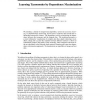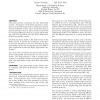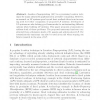NIPS
2008
14 years 1 months ago
2008
We introduce a family of unsupervised algorithms, numerical taxonomy clustering, to simultaneously cluster data, and to learn a taxonomy that encodes the relationship between the ...
LREC
2008
14 years 1 months ago
2008
This paper presents the process of acquiring a large, domain independent, taxonomy from the German Wikipedia. We build upon a previously implemented platform that extracts a seman...
COLING
2008
14 years 1 months ago
2008
In this paper we present a taxonomy of dialogue moves which describe the actions that students and tutors perform in tutorial dialogue. We are motivated by the need for a categori...
ECAI
2008
Springer
14 years 2 months ago
2008
Springer
We present a taxonomy automatically generated from the system of categories in Wikipedia. Categories in the resource are identified as either classes or instances and included in a...
HT
1996
ACM
14 years 4 months ago
1996
ACM
This paper presents a taxonomy for open hypermedia systems. The purpose of the Flag1 taxonomy is manifold: 1 to provide a framework to classify and concisely describe individual s...
SIGCSE
1999
ACM
14 years 4 months ago
1999
ACM
Algorithms have cometo be recognizedasthe cornerstone of computing. Surprisingly, there has been little research or discussion of general techniques for designing algorithms. Thou...
WISE
2002
Springer
14 years 5 months ago
2002
Springer
Taxonomies are a well-established instrument for organizing and accessing resources in Information, Content and Knowledge Management (ICKM) systems. Furthermore, they contribute t...
ICDCSW
2002
IEEE
14 years 5 months ago
2002
IEEE
Event-based middleware is currently being applied for application component integration in a range of application domains. As a result, a variety of event services have been propo...
KR
2004
Springer
14 years 5 months ago
2004
Springer
The Halo Pilot, a six-month effort to evaluate the state-ofthe-art in applied Knowledge Representation and Reasoning (KRR) systems, collaboratively developed a taxonomy of failure...
LOCA
2007
Springer
14 years 6 months ago
2007
Springer
Abstract. Location Fingerprinting (LF) is a promising location technique for many awareness applications in pervasive computing. However, as research on LF systems goes beyond basi...




